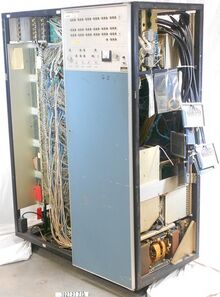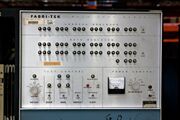Difference between revisions of "Fabritek Core Memory"
m |
m (→External links: At the CHM) |
||
| (4 intermediate revisions by 2 users not shown) | |||
| Line 1: | Line 1: | ||
| − | [[Image:Moby.JPG| | + | [[Image:Moby.JPG|220px|right|thumb|The "Moby" Memory]] |
| − | 256K x 40 bit core memory. | + | The '''Fabritek Core Memory''' was 256K x 40 bit [[core memory]] for the [[PDP-6]] and [[KA10]]. |
Former Fabri-Tek engineer Gary Andersen told this story: | Former Fabri-Tek engineer Gary Andersen told this story: | ||
| − | ''It was one of the first 1 MB add on memories, if not the first, built by a third party vendor. I gave a paper on the design at the Spring Joint Computer show in Manhattan in May of 1965. Dr. Marvin Minsky, from his artificial intelligence lab, [was in the audience]. Unshaven, in a white dress shirt hanging out in back, and in sock-less sandal shoes he came up to me and said, “I want one.” | + | ''It was one of the first 1 MB add on memories, if not the first, built by a third party vendor. I gave a paper on the design at the Spring Joint Computer show in Manhattan in May of 1965. Dr. Marvin Minsky, from his artificial intelligence lab, [was in the audience]. Unshaven, in a white dress shirt hanging out in back, and in sock-less sandal shoes he came up to me and said, “I want one.”'' |
| − | I said, all we have is a prototype. His response was, “I don’t care. Thanks. When you be in Boston again?” Two weeks later our sales guy and I negotiated a 1 MB add on for his DEC PDP6 computers, one of only 26 PDP6 computers made, for about $230,000 for a 5 microsecond cycle time memory that used 80m ferrite cores, plus another $5000 for every 1/2 microsecond better cycle time, I believe. He wrote the order number on the back of an envelope. | + | ''I said, all we have is a prototype. His response was, “I don’t care. Thanks. When you be in Boston again?” Two weeks later our sales guy and I negotiated a 1 MB add on for his DEC PDP6 computers, one of only 26 PDP6 computers made, for about $230,000 for a 5 microsecond cycle time memory that used 80m ferrite cores, plus another $5000 for every 1/2 microsecond better cycle time, I believe. He wrote the order number on the back of an envelope. '' |
| − | We didn’t believe it, but a week later a hard copy purchase order came from MIT. It was a real chore. Not only the memory, but also the interface. As I remember DEC wasn’t real cooperative. It was a long haul, but we finished and got paid $240,000, I believe'' | + | [[Image:Fabri-tekPDP-10CoreMemory.jpg|180px|left|thumb|Control panel]] |
| + | |||
| + | ''We didn’t believe it, but a week later a hard copy purchase order came from MIT. It was a real chore. Not only the memory, but also the interface. As I remember DEC wasn’t real cooperative. It was a long haul, but we finished and got paid $240,000, I believe'' | ||
| + | |||
| + | {{semi-stub}} | ||
== External links == | == External links == | ||
* [https://ljkrakauer.com/LJK/60s/moby.htm "Moby Memory", by Larry Krakauer] | * [https://ljkrakauer.com/LJK/60s/moby.htm "Moby Memory", by Larry Krakauer] | ||
| + | * [https://www.computerhistory.org/collections/catalog/102731715 FABRI-TEK Mass Core "Moby" Memory] - at the [[Computer History Museum|CHM]] | ||
| − | + | [[Category: PDP-10 Memories]] | |
| − | |||
| − | [[Category:PDP-10 | ||
Latest revision as of 19:53, 4 February 2024
The Fabritek Core Memory was 256K x 40 bit core memory for the PDP-6 and KA10.
Former Fabri-Tek engineer Gary Andersen told this story: It was one of the first 1 MB add on memories, if not the first, built by a third party vendor. I gave a paper on the design at the Spring Joint Computer show in Manhattan in May of 1965. Dr. Marvin Minsky, from his artificial intelligence lab, [was in the audience]. Unshaven, in a white dress shirt hanging out in back, and in sock-less sandal shoes he came up to me and said, “I want one.”
I said, all we have is a prototype. His response was, “I don’t care. Thanks. When you be in Boston again?” Two weeks later our sales guy and I negotiated a 1 MB add on for his DEC PDP6 computers, one of only 26 PDP6 computers made, for about $230,000 for a 5 microsecond cycle time memory that used 80m ferrite cores, plus another $5000 for every 1/2 microsecond better cycle time, I believe. He wrote the order number on the back of an envelope.
We didn’t believe it, but a week later a hard copy purchase order came from MIT. It was a real chore. Not only the memory, but also the interface. As I remember DEC wasn’t real cooperative. It was a long haul, but we finished and got paid $240,000, I believe

